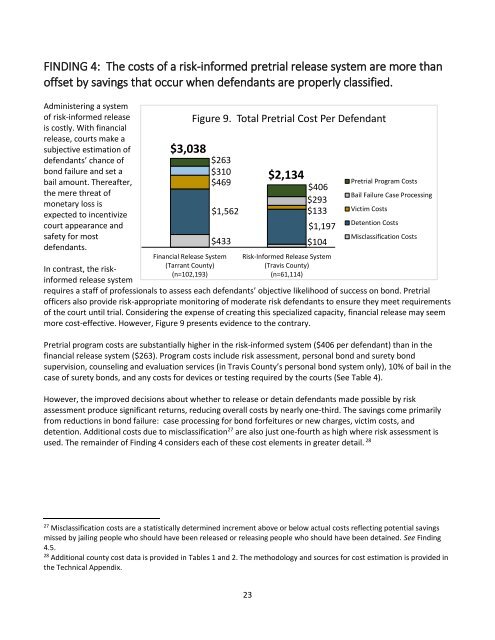LIBERTY AND JUSTICE PRETRIAL PRACTICES IN TEXAS
170308_bond-study-report
170308_bond-study-report
You also want an ePaper? Increase the reach of your titles
YUMPU automatically turns print PDFs into web optimized ePapers that Google loves.
F<strong>IN</strong>D<strong>IN</strong>G 4: The costs of a risk-informed pretrial release system are more than<br />
offset by savings that occur when defendants are properly classified.<br />
Administering a system<br />
of risk-informed release<br />
is costly. With financial<br />
release, courts make a<br />
subjective estimation of<br />
defendants’ chance of<br />
bond failure and set a<br />
bail amount. Thereafter,<br />
the mere threat of<br />
monetary loss is<br />
expected to incentivize<br />
court appearance and<br />
safety for most<br />
defendants.<br />
In contrast, the riskinformed<br />
release system<br />
$3,038<br />
$263<br />
$310<br />
$469<br />
$1,562<br />
Financial Release System<br />
(Tarrant County)<br />
(n=102,193)<br />
Figure 9. Total Pretrial Cost Per Defendant<br />
$2,134<br />
$406<br />
$293<br />
$133<br />
$1,197<br />
$433 $104<br />
Risk-Informed Release System<br />
(Travis County)<br />
(n=61,114)<br />
Pretrial Program Costs<br />
Bail Failure Case Processing<br />
Victim Costs<br />
Detention Costs<br />
Misclassification Costs<br />
requires a staff of professionals to assess each defendants’ objective likelihood of success on bond. Pretrial<br />
officers also provide risk-appropriate monitoring of moderate risk defendants to ensure they meet requirements<br />
of the court until trial. Considering the expense of creating this specialized capacity, financial release may seem<br />
more cost-effective. However, Figure 9 presents evidence to the contrary.<br />
Pretrial program costs are substantially higher in the risk-informed system ($406 per defendant) than in the<br />
financial release system ($263). Program costs include risk assessment, personal bond and surety bond<br />
supervision, counseling and evaluation services (in Travis County’s personal bond system only), 10% of bail in the<br />
case of surety bonds, and any costs for devices or testing required by the courts (See Table 4).<br />
However, the improved decisions about whether to release or detain defendants made possible by risk<br />
assessment produce significant returns, reducing overall costs by nearly one-third. The savings come primarily<br />
from reductions in bond failure: case processing for bond forfeitures or new charges, victim costs, and<br />
detention. Additional costs due to misclassification 27 are also just one-fourth as high where risk assessment is<br />
used. The remainder of Finding 4 considers each of these cost elements in greater detail. 28<br />
27<br />
Misclassification costs are a statistically determined increment above or below actual costs reflecting potential savings<br />
missed by jailing people who should have been released or releasing people who should have been detained. See Finding<br />
4.5.<br />
28<br />
Additional county cost data is provided in Tables 1 and 2. The methodology and sources for cost estimation is provided in<br />
the Technical Appendix.<br />
23


